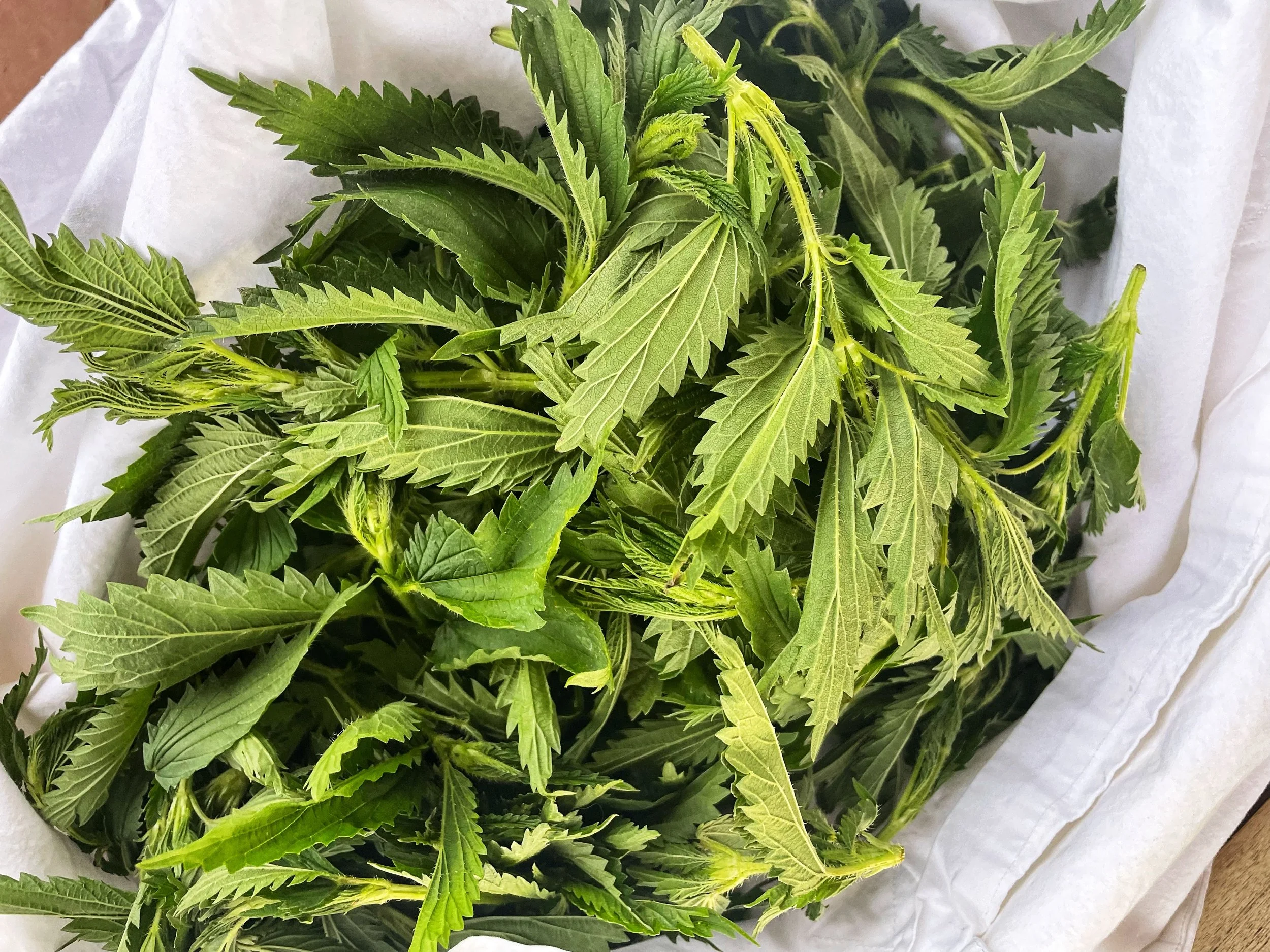As winter wanes and spring arrives, so do tender, young greens. There are dozens of delightful edible and medicinal plants to harvest during this time of year, but one that I look most forward to gathering is stinging nettle. Stinging nettle is a perennial plant that is often considered a weed by many gardeners. However, this plant has a long history of medicinal use and is also a great source of food and fiber. Despite its notorious sting, nettle is a valuable plant that deserves more recognition.
Plant Characteristics: Stinging nettle (Urtica dioica) is a herbaceous plant that can grow up to 2 meters tall. The plant has deeply serrated leaves and produces small, greenish-white dense clusters of flowers (the clusters of buds look similar to those of lambsquarter and amaranth). The leaves and stems of the plant are covered in small, stinging hairs that can cause a painful reaction when touched. Although nettle is native to Europe, Asia, and North Africa, it can be found in temperate regions throughout the world—including all across the US.
Common Uses: This plants is a powerhouse of nutritional and medicinal properties—a true superfood. Nettle is rich in vitamins, minerals, and antioxidants. The leaves can be cooked and eaten like spinach or pureed into a basil-free pesto, and both cooking and emulsifying deactivate the sting. Nettle soup is a traditional dish in many parts of Europe.
Stinging nettle has also been used for centuries in traditional medicine to treat a variety of ailments due to its anti-inflammatory, analgesic, and diuretic properties. It is commonly used to treat arthritis, allergies, urinary tract infections, and skin conditions such as eczema and psoriasis. Nettle tea is a popular remedy for allergies, as it contains histamine, which can help to reduce the symptoms of hay fever and other allergies. It is also a natural diuretic and can be used to treat water retention and kidney problems.
But wait… there’s more! Stinging nettle is also a valuable source of fiber for making a variety of household goods. In fact, the fibers from the stem of the nettle plant can be used to make cloth, paper, and rope. Nettle fibers are strong and durable, and were used to make clothing before the widespread use of cotton. In addition, nettle makes a lovely natural dye.
Growing and Gathering: Stinging nettle is easy to grow and can be cultivated in a variety of soils and climates. The plant prefers moist, fertile soil and partial shade, but can also tolerate full sun. Seeds can be sown in the spring or fall, and the plant can also be propagated by division. I often find it in agricultural fields and alongside creeks and seasonal streams. To avoid the sting, it is smart to wear gloves when harvesting, although with practice one can learn to harvest by hand easily without much bother. The plant should be harvested when the leaves are young and tender, before the plant flowers. The leaves can be dried for later use, or used fresh in cooking and medicinal preparations.
So there you have it. Despite its reputation as a weed, stinging nettle is an incredibly valuable source of food, medicine, fiber, and dye, and can be easily cultivated in a home garden or gathered from the wild. Care will help you avoid the sting, and the benefits make it a plant that is definitely worth getting to know.
Stinging Nettle Cake Recipe
Stinging nettle cake may sound unusual, but it is a delicious way to incorporate this nutritious and medicinal plant into your diet. Here is a recipe for a moist and flavorful stinging nettle lemon cake:
Ingredients:
2 cups of stinging nettle leaves
1 1/2 cups all-purpose flour
1 cup sugar
1/2 cup coconut or vegetable oil
3 large eggs (or chia/flax equivalent)
1 tsp baking powder
1 tsp baking soda
1 tsp vanilla extract
1 lemon, juiced and zested
1/2 tsp salt
Instructions:
Preheat the oven to 350°F (175°C) and grease a 9-inch cake pan.
Blanch the stinging nettle leaves in boiling water for 1 minute, then rinse with cold water, strain, and chop finely.
In a mixing bowl, combine the flour, baking powder, baking soda, lemon zest, and salt.
In a separate bowl, whip the eggs and sugar until slightly frothy.
Add the vegetable oil, vanilla extract, lemon juice, and chopped stinging nettle leaves to the egg mixture and stir well.
Gradually fold in the flour mixture until the batter is smooth.
Pour the batter into the prepared cake pan and bake for 30-35 minutes, or until a toothpick inserted into the center of the cake comes out clean.
Allow the cake to cool in the pan for 10 minutes, then transfer to a wire rack to cool completely.
Serve the stinging nettle cake with a dollop of whipped cream or a dusting of powdered sugar. It is a unique and flavorful dessert, and the earthy flavor of the stinging nettle pairs well with the sweetness of the cake, creating a balanced and delicious treat.
